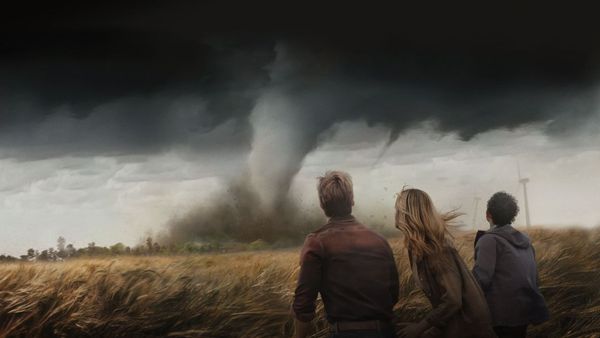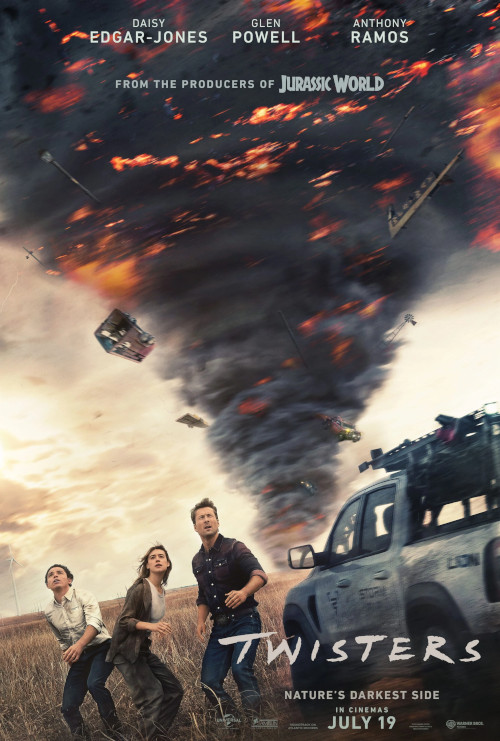Eye For Film >> Movies >> Twisters (2024) Film Review
Twisters
Reviewed by: Andrew Robertson

Twisters joins a succession of sequels that are also plurals. Alien had Aliens, Predator would go through a few attempts before landing on Predators. Anaconda had Anacondas, and there's time yet for a singular prequel to Jaws. While of widely varying quality, and equally wide spacing, you will have noticed that these are all monster movies, some of which are differently science fictional. Twisters is more of the same.
Of the numerous callbacks and borrowings perhaps one of the most pleasing is the return of actor Darryl Cox. In the original Twister he (uncredited) played a mechanic; in the interim he had a role in director Lee Isaac Chung's Oscar-winner Minari, and in Twisters he's no longer fixing vehicles but selling them. It's a tiny part of the film, but it's one of the more satisfying comic beats. April Warren also returns, but the chronology of that is even more confusing as she appeared in the first one in flashback.

That lack of cast continuity is in part tragic, many of Twister's cast are no longer with us. Plenty of them are still working though, and with a finite number of meteorological departments out there it's surely logical that at least one of the first film's doctors was a PhD supervisor for one of this film's postgraduates. There is a role for Bill's son James Paxton, but given how often Twisters loops back to its wellspring it's sad that there are so few returning faces.
Chung's an interesting choice for this, though there's precedent. After Chloe Zhao did Nomadland she did The Eternals but she was attached before her Oscar win. A strong showing at Sundance for The Rider getting her the keys to the MCU executive washroom. Twister was helmed by Jan de Bont, whose long legacy as a director of photography for action films saw him brought on to direct Speed and then Twister. His skill with the setpiece and special effect set him up well for those, though later outings illustrated how hard it is to keep lightning in a bottle.
Minari is a tale of the American midwest, and Twisters seems relentlessly targeted at it. This includes disparaging remarks about 'city girl' Kate (Daisy Edgar-Jones), many of which come from tornado-wrangler Tyler (Glen Powell). Anthony Ramos as Javi(er) helps mirror the 'conflicts' in Twister, corporate interests against something akin to citizen science.
Among the weirdly dismissive things said is a line from Javi, explaining that Tyler has "a million subscribers on YouTube". I'm not sure if it's meant to be read as a disdain for popularity or that those numbers aren't much. There are roughly three thousand YouTube channels with more than a million subscribers, and even if you've heard of any you've certainly not heard of them all. While trying to figure out how those subscriber numbers stack up I discovered Reed Timmer whose livestreams of storm chasing are shot from the fortified vehicle Dominator 3. Like Tyler's crew-cabbed Dodge RAM 3500 Heavy Duty pickup truck it has ground-anchoring augurs, rocket-launching equipment. Unlike the movie car it's actually got armour, looking like a mine-resistant vehicle more than anything you'd see on a ranch. While they've got 'harnesses' I'm not convinced that the four-point seatbelt would do that much especially when we see cars flung through the air, but I was paying close attention because I had noticed something missing.
The phrase 'once-in-a-generation' is used several times, but 'climate change' isn't spoken once. There are baddies in this film too, but Hollywood tries to have its mildly anticapitalist cake and eat it. As in Breakin' 2: Electric Boogaloo and Police Academy 6: City Under Siege, the real villain is real estate speculation. I don't think that constitutes spoilers, if only because the film needs something to induce a degree of conflict in its human cast other than wind.
There's a bit of romantic tension, and it's potentially refreshing how that plays out. There's a bit of survivor's guilt, a bit of small-town girl comes home, that last really subtly played with nothing as obvious as a denim jacket with an American flag on the back worn over a faded Pat Benatar t-shirt as signal of a return to roots. I'm being facetious here, because if I hadn't seen Civil War I'd think this was a low point for trying to avoid politics and in so doing engage in just that. An exchange about the differences between Oklahoma and New York City feels pitched to allow each side of the urban/rural divide to feel like it's in the right. It's also massively cliched, and literally middle of the road. There's a later scene where someone's asked "Whose side are you on?" and they explain that they "care about the people."
Written by Mark L Smith and Joseph Kosinski, based on elements from Michael Crichton and Anne-Marie Martin's original script, it's a monster movie whatever its box office returns will be. It'll doubtless get nods on either side of whatever the Academy decides on this year for the dividing line between Sound Design and Sound Editing. The anthropomorphic breathing of the tornadoes is somewhere between the animal howls of the fires of Backdraft and the labour of V8 incarnate from Fury Road. Skywalker Sound are credited, and they know their audio onions. Various firms contribute effects. Industrial Light & Magic had several personnel return from the first but at least five others are involved. There's an action movie staple of the 'flame and steam factory', industrial facilities that seem to exist only to threaten our heroes with combustion and condensation. By having a tornado rampage through a refinery complex, there's scope for both.
Benjamin Wallfisch's score makes significant use of wind instruments and choral voices. That's often lost though among the roar of effects and a score that never strays from both kinds of music, country and western. Two of the songs on the soundtrack album have 'ain't' in the title; that's almost 7%. Wallfisch has done a lot of genre films, among the bigger ones other sequels like Blade Runner 2049.
Twisters is one, to be clear. Natural disaster as monster, mainstream horror, when lines allude to tornadoes coming for "people we love" it's blurring a line between threat and agency. There's a shot of a character limping that widens and pans to show an amount of carnage that could fit without effort into everything from air-crashes to zombies. Mark L Smith wrote two very different slices of Americana. He helped adapt the books that were the source for The Revenant and The Boys In The Boat (following the US rowing team to the 1936 Olympics). Joseph Kosinski penned and directed Tom Cruise vehicle Oblivion and helmed sequel Top Gun: Maverick. He's no stranger to second outings - Tron Legacy was one of his too. There's a fair few directors in various roles behind the camera. Steven Spielberg's Amblin is one of the production firms involved.
I find myself returning to the business they call show because it's often visible. Ignoring return to a film nearly 30 years later, product placement for Budweiser (and Bud Light for the ladies) feels as dropped-in as any livestock. What I had interpreted as an indicator that a vehicle was electric turned out to be a naming convention that drew from the Yellow Brick Road and not the periodic table. There's a shot that comes from a camera moving around protagonists that uses rotational parallax to disconcert and centre, and that's pure 'Bayhem'. Michael Bay's career took off shortly before Twister, and Bad Boys is still going as a franchise too. A segment with a runaway trolley car reminded me of the old Universal Studios ride King Kong Encounter, and a collapsing water tower was lifted straight from Warner Brothers. There are no airborne bicycles, but a brimmed hat on a doctor has more than a whiff of Henry Jones Jr. The credits with a montage of newspaper headlines and magazine covers don't feel as old-fashioned as they do cribbed from the Monarchverse adventures of Godzilla X Kong.
I mention a lot of other films, because there is a sequence where folk hole up in a picturehouse. It speaks well to the health of repertory cinema in Oklahoma that you can apparently see Frankenstein (1931) midway through a weekday. It's maybe more on the nose that films are imperiled, that digital effects threaten to destroy a movie theatre, but someone (not Tom Cruise) can save them. I'm not sure Twisters is it though.
I thought it had the same weird ethos as Twister, and as I said the absence of the words 'climate change' felt like cowardice or cold capitalist calculation. Maybe both. The sound quality makes it worth seeing on the big screen. Even though wind and mist might unbelievably lift for dramatic effect when they are present they're immersive. It's big and loud and works very hard to signify nothing, but like the eye of a hurricane, gaps can be important. I'm not sure if it counts as a sequel as much as a remake. There's so much that still goes unexamined, whole elements repeatedly visited but unresolved which vary in size from aeroplanes to farms. There's repeated mention of military-grade radar but there's no government funding here, and it's yet another absence where I'm not sure if the fact it's missing matters.
Twisters spins a pretty thrilling yarn, but it doesn't bear close scrutiny. Watching it weave a path that circularly skirts issues will make some viewers dizzy.
Reviewed on: 17 Jul 2024
















